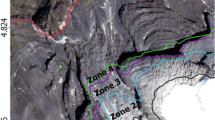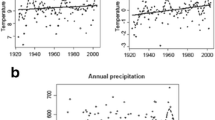Abstract
The fate of alpine species in response to climate warming is still unclear. We analyze effects of climate warming on the composition of alpine plants communities and unravel the range filling of communities within a belt from long-term true upward shift processes. In the European Alps we re-sampled in 2003 the vegetation at sites studied in 1953 and analyzed the changes at intra- and inter-community level. Since 1953 all communities experienced a high species turnover, leading to an overall increase in species richness as new species exceeded species losses. The dominant species mainly declined allowing the potential expansion of competitors and/or of new species. The main recruitment sources are neighbor communities within the same elevation belt performing biotic exchanges with other plant communities in the same altitudinal belts. The changes of species distribution curves with elevation emphasized that more than half of the most widespread persisting species exhibited downward shifts instead of upward shifts. Upward shifts from lower elevation belts and of nonnative species were very limited. One third of the persisting species declined and could be used as a proxy to measure the extinction debt. Therefore the fate of plant communities will depend on the ability of the original species to persist and fill the available ecological gaps. Species persistence may be crucial in developing adaptation and environmental protection strategies.



Similar content being viewed by others
References
Birks JHB, Willis KJ (2008) Alpines, trees, and refugia in Europe. Plant Ecol Divers 1(2):147–160
Breshears DD, Huxman TE, Adams HD et al (2008) Vegetation synchronously leans upslope as climate warms. PNAS 105:11591–11592
Cannone N, Gerdol R (2003) Vegetation as an ecological indicator of surface instability in rock glaciers. Arct Antarct Alp Res 35:384–390
Cannone N, Sgorbati S, Guglielmin M (2007) Unexpected impacts of climate change on alpine vegetation. Front Ecol Environ 5(7):360–365
Cannone N, Diolaiuti G, Guglielmin M, Smiraglia C (2008) Accelerating climate change impacts on alpine glacier forefield ecosystems in the European Alps. Ecol Appl 18:637–648
Cannone N, Lewkowicz AG, Guglielmin M (2010) Vegetation colonization of permafrost-related landslides, Ellesmere Island, Canadian High Arctic. J Geophys Res 115, G04020
Chao A, Chazdon RL, Colwell RK, Shen TJ (2005) A new statistical approach for assessing similarity of species composition with incidence and abundance data. Ecol Lett 8:148–159
Dirnböck T, Essl F, Rabitsch W (2011) Disproportional risk for habitat loss of high-altitude endemic species under climate change. Glob Chang Biol 17:990–996
Dullinger S, Gattringer A, Thuiller W et al (2012a) Extinction debt of high-mountain plants under twenty-first-century climate change. Nat Clim Chang 2:619–622
Dullinger S, Willner W, Plutzar C et al (2012b) Post-glacial migration lag restricts range filling of plants in the European Alps. Glob Ecol Biogeogr 21:829–840
Elmendorf SC, Henry GHR, Hollister RD et al (2012) Global assessment of experimental climate warming on tundra vegetation: heterogeneity over space and time. Ecol Lett 15:164–175
Engler R, Randin CF, Thuiller W et al (2011) 21st century climate change threatens mountain flora unequally across Europe. Glob Chang Biol 17:2330–2341
Fisher M, Stöcklin J (1997) Local extinctions of plants in remnants of extensively used calcareous grasslands 1950–1985. Conserv Biol 11(3):727–737
Gehrig-Fasel J, Guisan A, Zimmermann NE (2007) Tree line shifts in the Swiss Alps: climate change or land abandonment? J Veg Sci 18:571–582
Giacomini V, Pignatti S (1955) Flora e vegetazione dell’alta valle del Braulio con speciale riferimento ai pascoli di altitudine. Mem Soc Ital Sci Nat 11:47–238
Gottfried M, Pauli H, Futschik A et al (2012) Continent-wide response of mountain vegetation to climate change. Nat Clim Chang 2:111–115
Holzinger B, Hülber K, Camenisch M, Grabherr G (2008) Changes in plant species richness over the last century in the eastern Swiss Alps: elevational gradient, bedrock effects and migration rates. Plant Ecol 195:179–196
Jackson ST, Sax DF (2009) Balancing biodiversity in a changing environment: extinction debt, immigration credit and species turnover. Trends Ecol Evol 25(3):153–160
Keller F, Goyette S, Beniston M (2005) Sensitivity analysis of snow cover to climate change scenarios and their impact on plant habitats in alpine terrain. Clim Chang 72:299–319
Kelly AE, Goulden ML (2008) Rapid shifts in plant distribution with recent climate change. PNAS 105(33):11823–11826
Kullman L (2010) Alpine flora dynamics: a critical review of responses to climate change in the Swedish Scandes since the early 1950s. Nord J Bot 28:398–408
Lauber K, Wagner G (1998) Flora helvetica. Verlag Paul Hapt Ed, Berne, p 1614
Lenoir J, Gégout JC, Marquet PA et al (2008) A significant upward shift in plant species optimum elevation during the 20th century. Science 320:1768–1771
Lenoir J, Gégout JC, Guisan A et al (2010) Going against the flow: potential mechanisms for unexpected downslope range shifts in a warming climate. Ecography 33:295–303
Lenoir J, Graae BJ, Aarrestad PA et al (2013) Local temperatures inferred from plant communities suggest strong spatial buffering of climate warming across Northern Europe. Glob Chang Biol 19:1470–1481
Maggini R, Lehmann A, Kery M et al (2011) Are Swiss birds tracking climate change? Detecting elevational shifts using response curve shapes. Ecol Model 222:21–32
Magurran AE (2004) Measuring biological diversity. Blackwell, Oxford
Pauchard A, Kueffer C, Dietz H et al (2009) Ain’t no mountain high enough: plant invasions reaching new elevations. Front Ecol Environ 7:479–486
Pauli H, Gottfried M, Reiter K et al (2007) Signals of range expansions and contractions of vascular plants in the high Alps: observations (1994–2004) at the GLORIA* master site Schrankogel, Tyrol, Austria. Glob Chang Biol 13:147–156
Pignatti S (1982) Flora d’Italia. Three volumes. Edagricole, Bologna
Randin CF, Engler R, Normand S et al (2009) Climate change and plant distribution: local models predict high-elevation persistence. Glob Chang Biol 15:1557–1569
Ross LC, Woodin SJ, Hester A et al (2010) How important is plot relocation accuracy when interpreting re-visitation studies of vegetation change? Plant Ecol Divers 3:1–8
Scherrer D, Körner C (2011) Topographically controlled thermal-habitat differentiation buffers alpine plant diversity against climate warming. J Biogeogr 38:406–416
Schöb C, Kammer PM, Choler P, Veit H (2009) Small-scale plant species distribution in snowbeds and its sensitivity to climate change. Plant Ecol 200:91–104
ter Braak CJF, Smilauer P (1998) CANOCO. Reference manual and user’s guide to CANOCO for windows. Software for canonical community ordination (ver. 4). Centre for Biometry, Wageningen
Theurillat JP, Guisan A (2001) Potential impact of climate change on vegetation in the European Alps: a review. Clim Chang 50:77–109
Vetaas OR (2002) Realized and potential climate niches: a comparison of four Rhododendron tree species. J Biogeogr 29:545–554
Walther G-R, Beißner S, Burga CA (2005) Trends in the upward shift of alpine plants. J Veg Sci 16:541–48
Westhoff V, van der Maarel E (1973). The Braun-Blanquet approach. In: Whittaker RH (ed.) Handbook of vegeta-tion science, part 5. Classification and ordination of communities. Junk, The Hague, pp 617–726
Wilhalm T, Niklfeld H, Gutermann W (2006) Katalog der Gefaesspflanzen Suedtirols. Folio Verl, Wien/Bozen
Acknowledgments
We wish to thank Prof. Georg Grabherr, Prof. Mauro Guglielmin, Prof. Renato Gerdol and Prof. Alessandro Chiarucci for their comments on a former version of this manuscript. We wish to thank Stelvio National Park for logistical support. Finally, we wish to thank two anonymous reviewers for their useful comments allowing to improve our paper.
Author information
Authors and Affiliations
Corresponding author
Electronic supplementary material
Below is the link to the electronic supplementary material.
Fig. 1
Comparison of medians, quartiles and ranges of the Bray Curtis Distances between all iterative combinations of a) original to replicate plots (Or-Repl) and b) replicate plots (Between-Repl) for all selected vegetation communities, according to the procedure adopted by Ross et al. (2010). (DOCX 20 kb)
Fig. 2
Multivariate analysis (DCA) carried out at inter-community level analyzing the fully comparable relevés (1953 vs 2003) showing the species plot (left side) and the relevés plot (right side). Legend: OD: Pioneer community (n = 8); LA: early successional community (n = 10); SH: late melting snowbed (n = 28); AP: early melting snowbed (n = 24); CC: alpine grasslands (n = 18); LP: alpine dwarf shrubs (n = 12). (DOCX 546 kb)
Fig. 3
Biplot (species and sites) of the multivariate analysis (DCA) carried out analyzing the fully comparable relevés (1953 vs 2003) of pioneer (n = 4 for each year) and the early successional (n = 5 for each year) vegetation. Legend: square = pioneer vegetation; circle = early successional vegetation; white = 1953 data; grey = 2003 data. (DOCX 255 kb)
Fig. 4
Biplot (species and sites) of the multivariate analysis (DCA) carried out analyzing the fully comparable relevés (1953 vs 2003) of snowbeds (n = 26 for each year). Legend: white = 1953 data; grey = 2003 data. (DOCX 247 kb)
Fig. 5
Biplot (species and sites) of the multivariate analysis (DCA) carried out analyzing the fully comparable relevés (1953 vs 2003) of grasslands (n = 9 for each year) and alpine dwarf shrubs (n = 6 for each year). Legend: circles = grasslands; squares = alpine dwarf shrubs; white = 1953 data; grey = 2003 data. (DOCX 437 kb)
Table 1
(DOCX 14 kb)
Table 2
(DOCX 15 kb)
Table 3
(DOCX 15 kb)
Table 4
(DOCX 21 kb)
Rights and permissions
About this article
Cite this article
Cannone, N., Pignatti, S. Ecological responses of plant species and communities to climate warming: upward shift or range filling processes?. Climatic Change 123, 201–214 (2014). https://doi.org/10.1007/s10584-014-1065-8
Received:
Accepted:
Published:
Issue Date:
DOI: https://doi.org/10.1007/s10584-014-1065-8




